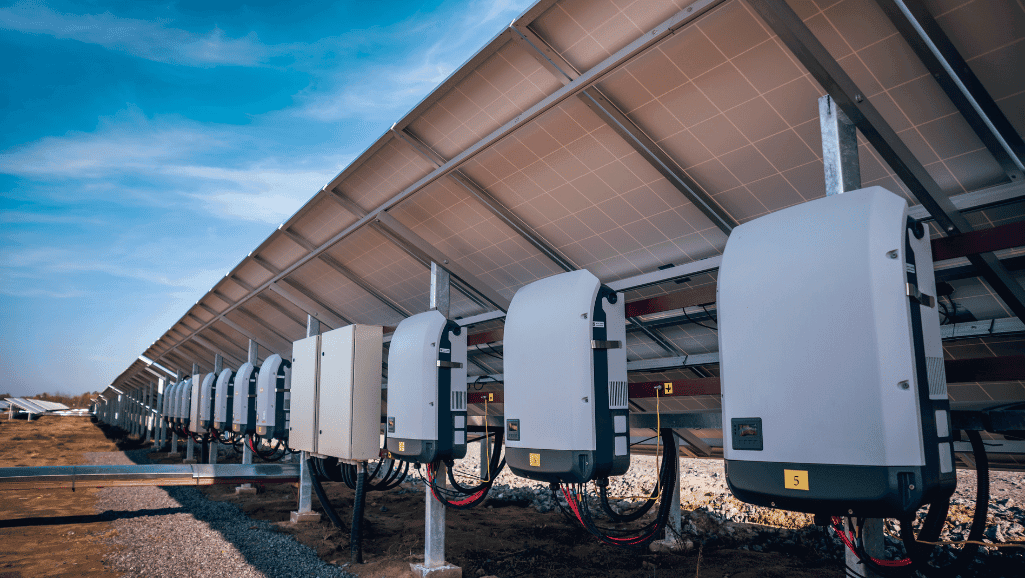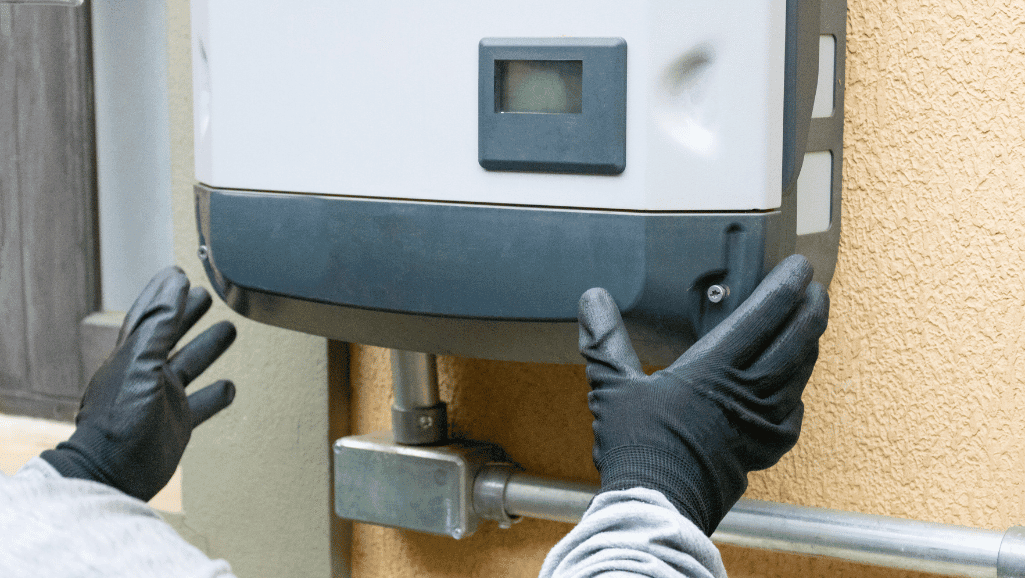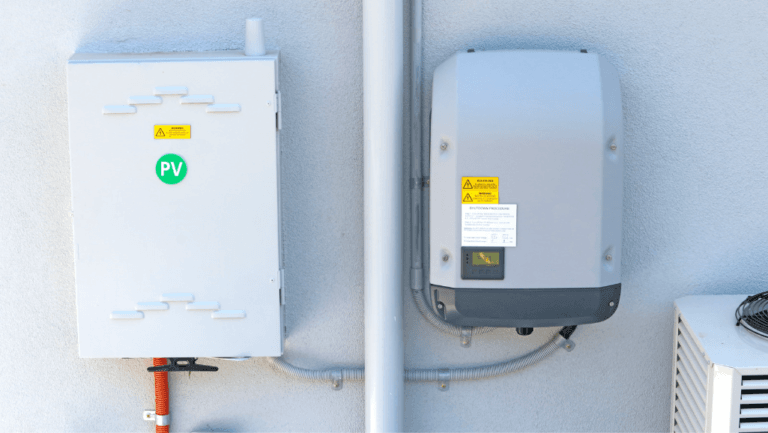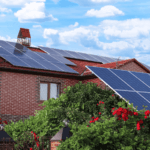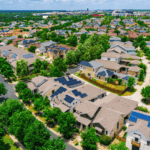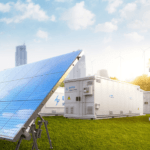Homeowners are now looking for sustainable energy solutions, and solar power is a top choice. The power inverter is key in solar setups, turning sunlight into electricity. Finding the best inverters boosts efficiency and increases a home’s solar power capacity. The SolarEdge Home Wave Inverter is a top pick, offering great performance and satisfaction.
The SolarEdge Home Wave Inverter meets various solar power needs with its high efficiency. This means less energy waste and more power for your home. Choosing the right inverter is important, and SolarEdge offers great options with a strong warranty and positive reviews. Even though it costs more upfront, the long-term benefits make it a smart choice.
Key Takeaways
- The importance of choosing the best solar inverters for optimized solar power conversion.
- SolarEdge Home Wave stands out for its exceptional efficiency and solid warranty.
- Investing in a high-quality solar inverter equates to reliable and efficient solar energy usage.
- Solar inverter warranties are a critical factor, with SolarEdge offering a compelling 12-year warranty.
- Understanding that premium inverters like SolarEdge provide not just power but peace of mind for households.
- Increased value over time with best-in-class inverters that deliver on power and performance promises.
- Exploring the merits of the SolarEdge inverter through high-scoring reviews and user satisfaction.
An Overview of Solar Inverter Importance
The solar inverter is key to making solar energy useful for daily life. It’s often overlooked but vital for solar power systems to work well.
What is a Solar Inverter?
A solar inverter changes the DC power from solar panels into AC power. This AC power can go into the electrical grid or be used locally. It’s essential for making solar energy useful.
Key Functions of Solar Inverters in Energy Systems
Solar inverters do more than just change DC to AC. They make solar panels work better by converting energy efficiently. They perform tasks that boost performance and make systems last longer.
- Optimal Energy Harvesting: Inverters use MPPT to make sure solar panels work best, even when sunlight and temperature change.
- Improved Energy Management: Some solar inverters have software for real-time power tracking. This makes energy use better and gives important data on energy use.
- System Longevity and Safety: Inverters help solar systems last longer by protecting against overloads and overheating. They also meet safety and regulatory standards.
Choosing the right solar inverter type is key to a system’s efficiency, cost, and greenness. Options range from string inverters for homes to microinverters for complex setups. The choice depends on the installation site’s needs.
Solar inverters blend advanced tech, important functions, and smart energy use. They’re crucial for efficient energy conversion and promoting green energy solutions.
The SolarEdge Home Wave Inverter: Peak Efficiency and User Satisfaction
The SolarEdge Home Wave Inverter is a top choice for residential solar inverters. It’s known for its solar inverter efficiency. This model offers many benefits that make users happy and satisfied.
The SolarEdge Home Wave Inverter has a top efficiency of 99.2%. This is higher than the usual 95-98%. Homeowners get more solar energy, which means lower bills and less harm to the environment. It also connects well with home automation systems, making energy management easy.
This inverter has special features like power optimization and works with electric vehicle charging. It’s a great choice for those who care about energy use. SolarEdge also offers a 12-year warranty, which can be up to 25 years, showing they trust their product a lot.
| Feature | Details |
|---|---|
| Efficiency Rating | Up to 99.2% |
| Warranty | 12 years, extendable up to 25 years |
| Additional Features | Power optimization, EV charging compatibility |
| Market Position | Premium segment, 20-40% more expensive than competitors |
Buying a SolarEdge Home Wave Inverter is more than just a purchase. It’s a step towards a green and efficient future. Each inverter shows SolarEdge’s commitment to quality and innovation in solar tech.
Understanding Solar Inverter Types and Their Impact on Performance
Choosing the right solar inverter is key to a system’s efficiency and reliability. We’ll look at string inverters, microinverters, and hybrid inverters. Each type has its own benefits and fits different needs and environments.
String Inverters: A Cost-Effective Choice
String inverters link solar panels together in a series. They’re a cost-effective option for areas with little shading. These inverters are simple and long-lasting, making them a favorite for homeowners. But, shading one panel can lower the whole string’s output.
They cost between $1,000 to $2,000. This makes them a budget-friendly choice for many homes.
Microinverters: Enhanced Efficiency and Flexibility
Microinverters sit on each panel, ensuring no panel affects the others. They’re great for complex or shaded roofs. By boosting each panel’s performance, they improve the system’s overall efficiency.
They’re pricier, adding $1,000 or more to the system. But, they offer better energy output and a 25-year warranty.
The Rise of Hybrid Inverters for Solar Systems
Hybrid inverters are gaining traction for their mix of string and battery features. They manage the solar array and connect to battery storage. This means more energy independence and backup power during outages.
Hybrid inverters cost between $1,000 and $3,000. They help store and use extra electricity, cutting down on grid power use.
Each inverter type has its own perks, making the choice depend on your system needs, budget, and environment. Knowing these differences is key to getting the most from your solar setup.
Exploring Top Solar Inverter Brands and Their Market Dominance
The solar inverter market is growing fast, thanks to new tech and better efficiency from solar inverter brands. These brands lead with their trustworthy solar gear and new ideas. They serve homes and businesses alike.
In 2022, solar power grew a lot. The top 10 solar PV inverter makers controlled 86% of the market dominance. This was thanks to a big jump in global PV demand to 201 GWac. This demand led to a 48% increase in PV inverter sales. Solar inverter brands are key to this growth, bringing new innovations to solar energy.
| Brand | 2022 Market Share | Global Shipment Growth |
|---|---|---|
| Huawei | 29% | 83% |
| Sungrow | 23% | 56% |
| SolarEdge | N/A | N/A |
| Tesla | N/A | N/A |
| Enphase | N/A | N/A |
The growth is happening all over the world. The APAC region leads with a 50% share, thanks to China. Europe and the U.S. also saw big increases in solar inverter sales.
These numbers show how important reliable solar equipment is for growing renewable energy. As these brands keep improving, using solar energy gets easier and more widespread. Solar energy is becoming a key part of the move to sustainable energy worldwide.
Factors Influencing Solar Inverter Efficiency and Longevity
Understanding what affects solar inverter performance and life is key to getting the most from solar tech. Important factors like solar inverter construction, installation impact, and the environment it’s in play big roles. They affect how well and long inverters work.
Robustness of Inverter Construction and Cooling Systems
The way a solar inverter is built is crucial for its efficiency and life. Inverters with top-notch parts and good cooling systems can handle tough conditions better. They also avoid overheating, which is important since a small temperature rise can shorten the life of parts like capacitors.
Impact of Installation Location on Inverter Performance
Where you put a solar inverter matters a lot for its performance. Putting them in places away from extreme weather can make them last longer. This keeps them working well and lowers the chance of breaking down from the environment. Keeping them cool and shaded helps keep the temperature right, which is good for the inverter’s life.
Also, keeping up with maintenance and checking for problems is key to staying efficient. Cleaning them and looking out for error codes helps avoid damage and keeps them running well.
| Statistic | Effect on Inverter Longevity and Efficiency |
|---|---|
| Efficiency levels of 93%-96% | Shows they work very well |
| Ambient temperature increase of 10 degrees | Could cut the life of important parts in half |
| Solar irradiation variations | Makes efficiency change during the day |
| Proper preventive maintenance | Very important for a long inverter life |
By focusing on solar inverter construction, thinking about installation impact, and following maintenance tips, we can make inverters last longer and work better.
Comparison of Solar Inverter Warranties: What Should You Expect?
When you look into solar technology, think about the solar inverter warranties. These warranties show how much trust manufacturers have in their products. They also affect what you expect from a warranty. Good inverters with strong warranties can help lower future costs and worries.
Looking into the warranties of top brands shows a lot of different coverage options. Standard string inverters usually have about 12-year warranties. This gives users a lot of security over time. On the other hand, microinverters and power optimizers often have 25-year warranties. This is true for products from Enphase and SolarEdge.
Fronius Inverters: Leading with a Comprehensive Warranty
Fronius is a big name in solar by offering a comprehensive warranty structure. This shows how confident they are in their technology. Their strong warranties give customers peace of mind for the product’s life.
Market Leading Warranties: Tesla and SolarEdge
Tesla and SolarEdge are known for their top-notch solar inverter warranties. SolarEdge offers a 12-year warranty for string inverters and a 25-year warranty for power optimizers. They also cover the cost of shipping when replacing parts, making things easier for customers.
But, these warranties don’t cover labor costs for putting in new parts. They might also exclude things like damage from nature or needing certified pros for installation. It’s key to read your solar inverter warranties well. This way, you know what’s covered and what’s not.
Strong solar inverter warranties can greatly benefit both homes and businesses. They show how reliable and long-lasting the solar power systems are.
Optimal Installation Practices for Solar Inverters
Getting your solar inverter to work well starts with optimal installation. With options like central inverters, microinverters, and power optimizers, each has its own set of rules. It’s crucial to follow practice guidelines for a good solar inverter installation.
| Type of Inverter | Installation Considerations | Cost/Performance Trade-offs |
|---|---|---|
| Central Inverters | Lower cost, simple setup, best for unshaded roofs | Less expensive but lower efficiency in shaded conditions |
| Microinverters (e.g., Enphase) | Complex roof layouts, minimal height of 500mm from the ground | Higher initial cost, enhanced performance in shaded areas |
| Power Optimizers | Works with central/string inverters, minimum 6 inches free space around unit | Mid-range cost, balances efficiency and expense |
Where you place your inverter matters. It should be in a spot that’s not too sunny, like under a garage or carport (optimal installation locations). Also, make sure there’s enough space around it for air to move freely. This helps keep your inverter running longer.
Looking after your inverter is key to its success. Clean it regularly and check it often to keep it working well. This helps it last longer and perform better.
When installing, think about safety and the environment. Following local rules, like NEMA ratings, protects your inverter from the elements. This makes sure your solar inverter installation is safe and works well.
Installing your solar inverter right is more than just following the manual. It’s about using practice guidelines that fit your area. Doing this protects your investment and makes your solar power system work better.
Cost Considerations for Solar Inverters: Affordability vs. Value
The solar industry is growing fast, making it key to understand inverter pricing and inverter affordability for homeowners. There are many options for different budgets and needs. Yet, finding the right balance between cost and long-term value is a challenge.
Understanding the Pricing Spectrum of Solar Inverters
Solar inverter costs vary a lot, based on the type and size needed. For example, standard string inverters for homes can cost between $1,500 and $3,000. This price is about 6% to 9% of the total solar system cost, which can be lower after tax credits. The initial cost is high, but considering the benefits in efficiency and durability changes the view from cost to investment.
Why Investing in Quality Upfront Can Save You Money Long-Term
In solar energy, the saying ‘you get what you pay for’ is often true. Investing in solar quality boosts energy conversion efficiency and saves money over time. High-quality inverters from brands like Fronius or SolarEdge can be up to 97% efficient. Even though they cost more at first, they last longer and need fewer repairs, saving money in the long run.
Also, solar inverters like microinverters are pricier but offer better performance. They cost 15% to 25% more than traditional string inverters. Yet, their advanced technology is key for solar panels to work well, turning direct current into alternating current for home use or grid feed-in.
Key Takeaway: Choosing an inverter should consider both upfront cost and long-term benefits. The focus should be on the value gained over the inverter’s life, not just inverter affordability.
| Inverter Type | Cost | Efficiency | Expected Lifetime |
|---|---|---|---|
| String Inverter | $1,500 – $3,000 | Up to 97% | 10-15 years |
| Microinverter | 15% – 25% more than String | Higher | 15-25 years |
User Reviews and Ratings: Real-World Insights on Solar Inverter Performance
When exploring solar energy systems, it’s key to look at solar inverter performance through user reviews. These reviews give deep insights that help with making choices. They show the good and bad of each model and offer real-world insights that matter a lot to buyers.
Solar energy’s effect on climate has made people want reliable and efficient solar inverters more than ever Many brands stand out because of their performance, warranties, and new tech.
| Brand | Model | Efficiency | Warranty | User Rating |
|---|---|---|---|---|
| SolarEdge | Home Wave Inverter | High | 12-25 years | 4.5/5 |
| Enphase | IQ8 microinverter | Solid | 25 years | 4.7/5 |
| Fronius | Primo | Moderate | Varied | 4.0/5 |
| SMA | Sunny Boy | Up to 97% | Standard | 4.3/5 |
| Chilicon Power | Microinverter | Lower | Limited | 3.8/5 |
Reviews often talk about more than just efficiency or warranty. They share how inverters work in real life, like in hot places or areas with lots of clouds. For example, SolarEdge’s Home Wave Inverter is praised for staying efficient in tough conditions. This meets what users expect from a good solar inverter performance.
People looking to buy a solar inverter also care about how easy it is to use and install. Brands like Enphase get good marks for these points. This feedback helps manufacturers make better products and helps new buyers understand solar installations.
Choosing the right solar inverter is very important. It requires looking at the detailed insights from real-world insights in user reviews. These reviews guide people through the complex specs to find an inverter that fits their energy needs well.
Maintaining Your Solar Inverter for Maximum Productivity
To get the most from your solar power system, keeping up with solar inverter maintenance is key. Solar inverters are vital as they turn DC electricity from solar panels into AC electricity we can use. Knowing how they work and what they need is crucial for their efficiency.
Regular Monitoring and Diagnostics: Ensuring Inverter Health
Keeping an eye on your solar inverter’s health is vital for its efficiency. Solar inverters should work with an efficiency of over 83%. If it’s lower, it’s not working well. Regular checks spot problems early, keeping performance high.
Experts suggest checking solar inverters once a year. This helps find and fix issues like isolation faults, restarting problems, or overheating. These issues can really cut down an inverter’s performance.
Best Practices for Solar Inverter Maintenance
Looking after your solar inverter right is key for its upkeep. Here are some top tips:
- Make sure it has enough space to breathe to avoid overheating—keep at least twelve inches around it.
- Check for error codes or oddities often. Update software as needed to keep it current.
- Use solar inverter health monitoring systems for real-time updates on how it’s doing.
Following the rules from manufacturers and groups like the Clean Energy Council is also vital. These rules help make sure your inverter works well with your solar panels.
| Check Frequency | Checklist Item |
|---|---|
| Annual Inspection | Professional overall system check for function and efficiency |
| Monthly | Visual inspection of inverter for any physical damages or error alerts |
| As needed | Update software to latest version to deal with any known issues |
| Bi-annual | Check cooling and ventilation systems to prevent overheating |
| Responsive | Immediate troubleshooting and repair after fault alerts |
By following these steps, your inverter will work better and last longer, usually 10 to 15 years. This boosts your solar energy system’s performance and effectiveness.
Conclusion
The journey to get the most out of solar power starts with picking the right solar inverter. We’ve looked at many options, from Renogy’s strong inverters to Enphase Energy’s easy-to-use ones. These show how wide the quality range is for those wanting sustainable energy.
The Renogy 700-watt and 3000-watt inverters are great for saving energy. The SunGold 6500-Watt Inverter offers a lot of power and lets you choose how it works.
Things like efficiency ratings and brands like Fronius and SMA Solar Technology show how important it is to choose the right solar inverter. They help with saving energy and money over time. In places like India, where power cuts are common, having a reliable solar inverter is very important.
Warranties of five to ten years show how confident manufacturers are in their products. This builds trust with customers.
So, whether you need high efficiency or something that fits your budget, you must do your homework. Choosing the right solar inverter means understanding your needs and finding an inverter that matches. This is key for a clean and strong energy future.


